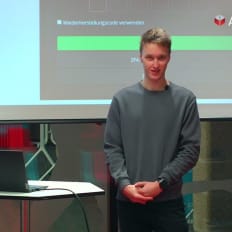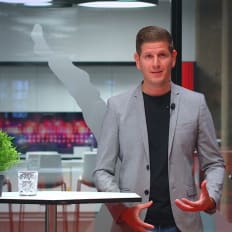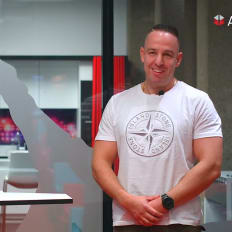
Auftragnehmerkataster Österreich
Dominik Zimmel, Product Owner bei ANKÖ
Description
Dominik Zimmel von ANKÖ spricht im Interview über seine Reise bis hin zur Arbeit als Product Owner, wie sein Arbeitsalltag aussieht und gibt nützliche Tipps für Anfänger.
By playing the video, you agree to data transfer to YouTube and acknowledge the privacy policy.
Video Summary
In “Dominik Zimmel, Product Owner bei ANKÖ,” Speaker Dominik Zimmel traces his path from HTL electrical engineering to a Digital Business degree and into product ownership to combine technology, business, and people-focused work. He defines the role as the bridge between IT and management: maintaining product strategy and vision, balancing legal requirements with user needs, and channeling user and support feedback into a market-ready product. His advice for aspiring POs is to embrace the connector role, build strong communication and teamwork skills, and apply analytical prioritization and technical understanding to tackle complex problems and assess long-term value.
From Electrical Panels to Product Strategy: Dominik Zimmel’s Path to Product Ownership at Auftragnehmerkataster Österreich
Introduction: A role you don’t choose; it finds you
“In the end, you don’t choose the Product Owner job; you find your way there.” That single line from the session “Dominik Zimmel, Product Owner bei ANKÖ” sets the tone. Speaker: Dominik Zimmel. Company: Auftragnehmerkataster Österreich. What follows is not a method checklist or a tool parade—it’s an unvarnished account of what it takes to hold a product together between law, user needs, and a team’s day-to-day reality.
From our DevJobs.at editorial vantage point, the strength of this talk is its groundedness. Dominik stays with the essentials: a technical origin he still values, a business mindset as a constant, and an uncompromising claim that communication and teamwork are non-negotiable. If you can’t do those, he says plainly, he cannot recommend the job. This article unpacks his milestones, challenges, and learnings—and translates them into applicable cues for engineers considering the move toward product leadership.
The first pivot: from electrical engineering to working with people
Dominik’s story starts in a technical, tactile world: he studied electrical engineering at a technical high school (HTL). He paints a hands-on picture—control cabinets, plant engineering, physical work, little time at the screen. The craft appealed to him, but something remained unmet: he wanted to talk to people and engage with management.
He describes the work in that field as receiving orders and executing them—often alone.
This is the decisive contrast: not a departure from tech, but a move toward a role where technology and people come together. The desire to connect technical depth with economic and interpersonal dimensions becomes the seed of his Product Owner path.
Digital Business: the bridge between tech and economics
Dominik then chose a Digital Business program, which he calls “super” because it ties together management and economics on one side with technology on the other. He lists the components plainly:
- Basics in programming
- Web development
- Management
- Cost accounting
- Economic feasibility
That lineup is the template for his way of working: in Product Ownership, economic viability is a constant consideration. As he puts it, you have to ask whether something is economically possible at all. For us, that’s a sorely needed reordering: technical feasibility is often discussed early, while economic viability shows up too late. Dominik flips that script.
What Product Ownership means in his words
When Dominik defines the role, three tensions stand out and repeat throughout his story:
1) Maintain product strategy and vision
2) Meet legal requirements
3) Honor user wishes and deliver a usable product
“As a Product Owner, you keep product strategy and vision alive while delivering legal requirements and user wishes in one package.”
That formula is demanding. It requires living with multiple truths—law, user perspective, and product goals—at once. For Dominik, the attraction lies precisely here: “a great opportunity to bring creative solutions” to complex problems. Creativity, in this sense, isn’t feature brainstorming; it’s combining constraints into viable answers.
Creativity under constraints: why he enjoys the tension
Dominik likes the difficulty of balancing legal requirements and user perspectives. There’s no lament in his tone; instead, there’s a builder’s curiosity. The thrill isn’t found in a frictionless innovation bubble—it lives in the contact zone where tech, law, and usage collide.
That’s a helpful reminder for anyone romanticizing Product Ownership: it’s less about novelty for novelty’s sake and more about disciplined synthesis. Strategy and vision are the bracket that ties law and need together at product level. That’s why Product Owners must hold multiple paths open without losing course.
Close to users: talk, listen, integrate
Dominik emphasizes feedback repeatedly: “It’s always important to include user feedback. You talk to people; you’re deeply involved with the team.” In his framing, conversations aren’t nice-to-haves; they’re core practice—holding discussions, finding common ground, integrating perspectives.
The role of Support is crucial in his account: “Support is very heavily involved … They’re close to customers and know very well what’s needed.” In many organizations, support is treated as an afterthought; in Dominik’s practice, it’s a primary input stream. The consequence is a working habit: keep asking, align continuously, leverage proximity to need to shape requirements early.
And the output standard is clear: “integrate requirements into the product so they’re market-ready and usable.” Input isn’t a product. The Product Owner’s value lies in turning raw signals into deliverables that hold up in real use.
Communication isn’t a bonus—it’s the foundation
Dominik is blunt. Without communication skills and team orientation, he wouldn’t recommend the job to anyone. That’s a strong filter—and a useful one. It shifts the question from “Which tools should I learn?” to “How do I work with people?”
“You need to talk well with people, hold discussions, and find a common denominator.”
That’s one of the talk’s most important lessons from our perspective. Communication here is not garnish; it’s the method. It structures, prioritizes, and connects. If you see yourself in this role, you should enjoy opening up meaning (What’s really being asked?), sharpening it (What’s truly important?), and closing it (What are we committing to?).
Analysis, prioritization, and parallelism: the inner workbench
Alongside communication, Dominik names cognitive capabilities that shape his daily practice:
- Think analytically
- Prioritize
- Run multiple things in parallel
That trio looks simple, but it sets a high bar. Analysis breaks problems apart, exposes dependencies, and reveals consequences. Prioritization organizes scarce resources, protecting focus and quality. Parallelism keeps the system moving without letting it fall into chaos.
What stands out is the practicality: he doesn’t recite buzzwords. He points to the concrete ability to deliver a good product under real constraints.
Technical understanding as a decision lever
“Technical understanding is an advantage, because in the end it’s about software development,” Dominik says. He explains why it matters: only with that understanding can you assess whether something pays off in the long run and whether an implementation is a “strong intervention” or not.
This isn’t the “Product Owner must be a coder” argument. It’s the insight that product decisions get better when you understand technical depth at least in terms of consequences. Dominik’s background—electrical engineering, Digital Business, programming basics—makes this stance credible. But the important bit is the why: technical literacy underpins judgment.
“How do you become a Product Owner?”—a heart choice, not a ladder
Pressed on the path into the role, Dominik refuses a tidy answer. The role is “young,” he says, and doesn’t map cleanly onto a single career ladder. What you need is to see yourself as the interface: “between IT and management,” capable of moving technical understanding toward management and translating management directives for the technical side.
“You need to understand technical things and convey them to management, and also make management directives comprehensible to the technical team.”
That double translation is the essence. If you dislike having to choose—pure tech or pure business—and find yourself thriving in the middle, Product Ownership may be your home. As Dominik puts it, you find yourself “between IT and management … and with Product Owner you close that middle perfectly.”
What engineers can take from this story—immediately applicable
Everything below flows from Dominik’s account; there’s no add-on advice beyond what he stresses in the session:
- Make structured conversations your craft. Discussions and the “common denominator” are at the core. In every meeting, practice clarifying where there’s agreement, what’s missing, and what’s misunderstood.
- Bring Support into the loop. If Support is closest to customers, it’s a prime source of needs. Set up regular, direct knowledge flows with the support team.
- Keep economics constant. Dominik names economic feasibility as a constant. Train yourself to think effort and value together—not sequentially.
- Prioritize with intent. Not everything can happen at once. Ask which decisions most strongly reinforce strategy and vision.
- Deepen technical understanding. Not to implement, but to judge: long-term value? Degree of intervention? Risk profile?
- Nurture teamwork. This role is cooperative by design. Without team and communication strength, it won’t work—Dominik is unequivocal about that.
Strategy and vision as living guardrails
When Dominik talks about “product strategy and vision,” he isn’t gesturing at abstractions. They are working tools, the guardrails that allow legal requirements and user wishes to come together “in one package.” Without those guardrails, discussions fray; with them, they become designable. The core questions emerge: How does this requirement serve the vision? Where does it collide with legal constraints? What does it take to bring both into alignment?
The reminder is simple: vision doesn’t mean vagueness; it enables decisions.
“Market-ready and usable”: from inputs to product
Dominik says his task is to integrate requirements into the product so they become “market-ready and usable.” That standard contains a lot of product discipline:
- Raw feedback gets organized and clarified.
- Wishes are checked against legal constraints and strategic direction.
- Implementation is shaped to be usable and durable.
Strikingly, this part of his story is unglamorous—and therefore credible. Product Ownership here is less showmanship and more craft.
The middle isn’t a compromise; it’s a responsibility
“You find yourself in the middle.” What could sound romantic, Dominik frames as duty: understand, translate, connect, decide. The middle is not a bargain; it’s a place of responsibility. To stand there, you need pleasure in conversation, the calm of analysis, and the courage to prioritize.
From our DevJobs.at lens, that’s the session’s strongest message. “Dominik Zimmel, Product Owner bei ANKÖ” (Speaker: Dominik Zimmel; Company: Auftragnehmerkataster Österreich) shows Product Ownership not as a title to collect but as a stance you assume—daily, conversation by conversation, decision by decision.
Key quotes and takeaways from Dominik Zimmel
“You don’t really choose the Product Owner job—you find your way there.”
“As a Product Owner, you keep product strategy and vision alive while delivering legal requirements and user wishes in one package.”
“It’s always important to include user feedback.”
“Support is very involved … close to customers and they know very well what’s needed.”
“Without communication skills and team orientation, I wouldn’t recommend this job to anyone.”
“You need to think analytically, prioritize, and run several things in parallel.”
“Technical understanding is an advantage … to judge if it pays off in the long run and whether it’s a strong intervention or not.”
“You have to understand technical things and convey them to management, and also make management directives understandable for the technical team.”
What teams can implement right now
- Treat Support as a compass. Build regular exchange formats with your support team—Dominik’s principle: customer proximity first.
- Separate inputs from product. Hold the standard that requirements must become “market-ready and usable”—not just documented.
- Make economic viability a constant. Always check feasibility twice: technically and economically.
- Strengthen discussion culture. Consensus shouldn’t be a fluke—it’s the output of conversation quality.
- Keep strategy and vision visible. They are the binding agent between law and user need.
Conclusion: Product Ownership as a heart choice—and the craft of connecting
Dominik Zimmel’s account in “Dominik Zimmel, Product Owner bei ANKÖ” is lucid: Product Ownership is less a pre-defined career ladder than a heart choice for the in-between. To thrive there, you need communication prowess, team spirit, analytical sharpness, prioritization muscle, and enough technical understanding to judge well.
For engineers who sense they want to do more than just build, his story is a strong guidepost: start with conversation, stay close to Support, keep economics constant, and anchor decisions in strategy and vision. The rest is craft—and daily responsibility.
That is how the middle becomes a place of impact: where law meets need, where teams listen to users, and where feedback becomes product. That is where Dominik Zimmel stands—as a Product Owner at Auftragnehmerkataster Österreich—and where the role finds its depth.




